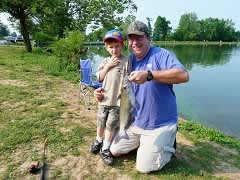Survey Finds Kentucky’s Fishing in Neighborhoods (FINs) Program Popular

A recent survey conducted at eight Fishing in Neighborhoods (FINs) lakes across Kentucky found the program both popular and helpful in recruiting new anglers.
“Feedback has been positive,” said Fisheries Biologist Dane Balsman, who manages the program for the Kentucky Department of Fish and Wildlife Resources. “About 85 percent of the anglers surveyed rated their overall fishing trip satisfaction as good or excellent.”
The FINs program, which started in 2006 with five pilot lakes, now includes 35 lakes in 22 counties, with the addition of Madisonville City Park Lake this spring. The 14-acre impoundment in Hopkins County brings the total acreage enrolled in the program to 194.5.
Other encouraging findings from the survey were that 10 percent of anglers had never previously bought a fishing license and 25 percent had not bought a fishing license the previous year. “Through the program, we are retaining previous license buyers and recruiting new ones,” said Balsman. “That’s one of our goals.”
Fishing license sales, excise taxes on fishing equipment and a 25 percent in-kind match from local governments fund the FINs program and annual stockings of fish.
Creating good fishing opportunities close to cities is a main goal of the program. Balsman said about 2.2 million people, or about half of Kentucky’s population, live in the 22 counties where the FINs lakes are located.
This year the plan is to stock more than 230,000 fish — 132,500 nine- to 12-inch rainbow trout and 98,650 12- to 16-inch catfish. These fish are large enough to be harvested at the time they are stocked.
The special creel and size limits in effect on the FINs lakes spread out fish harvest, providing fishing opportunities for the maximum number of anglers.
The standardized regulations of all 35 FINs lakes include a daily limit of five rainbow trout with no minimum size limit and a daily limit of four channel and blue catfish with no minimum size limit. There is a one-fish daily limit on largemouth bass with a 15-inch minimum size limit and a 15-fish daily limit on bluegill and other sunfish with no minimum size limit.
Next spring, anglers will have a new fish to add to their stringers. “From our survey we found that a lot of anglers like to catch sunfish, so we’re adding hybrid bluegill to the stocking plan,” said Balsman. “It’s a sterile, fast-growing cross between a bluegill and a green sunfish. Production has already started at the Pfeiffer Hatchery.”
The hybrid bluegills will be stocked beginning next spring on a lake-by-lake basis with some fish held in reserve for special events.
Despite all the successes, the future poses some challenges for the FINs program. “We’re close to the saturation point on the number of lakes we can have in the program,” said Balsman. “This is because we’re near capacity for the number of fish we can produce at our hatcheries.”
For more detailed information on Kentucky’s FINs program, including lake maps and directions, fish stocking schedules and fishing regulations, visit the department’s website at fw.ky.gov and click onto the “Fishing in Neighborhoods” logo.

